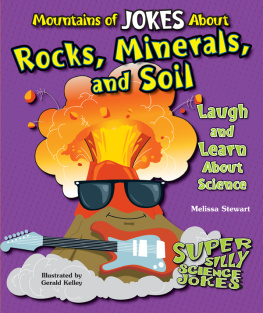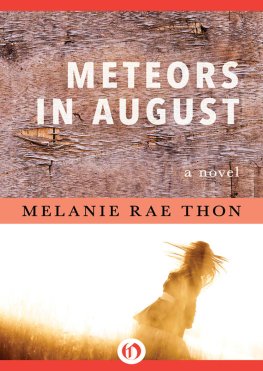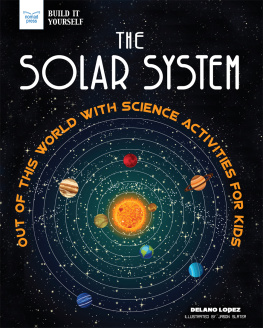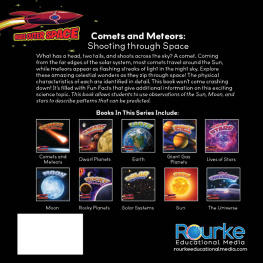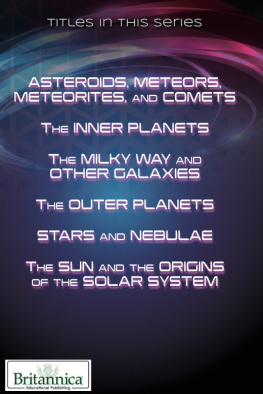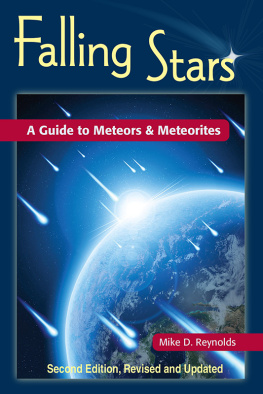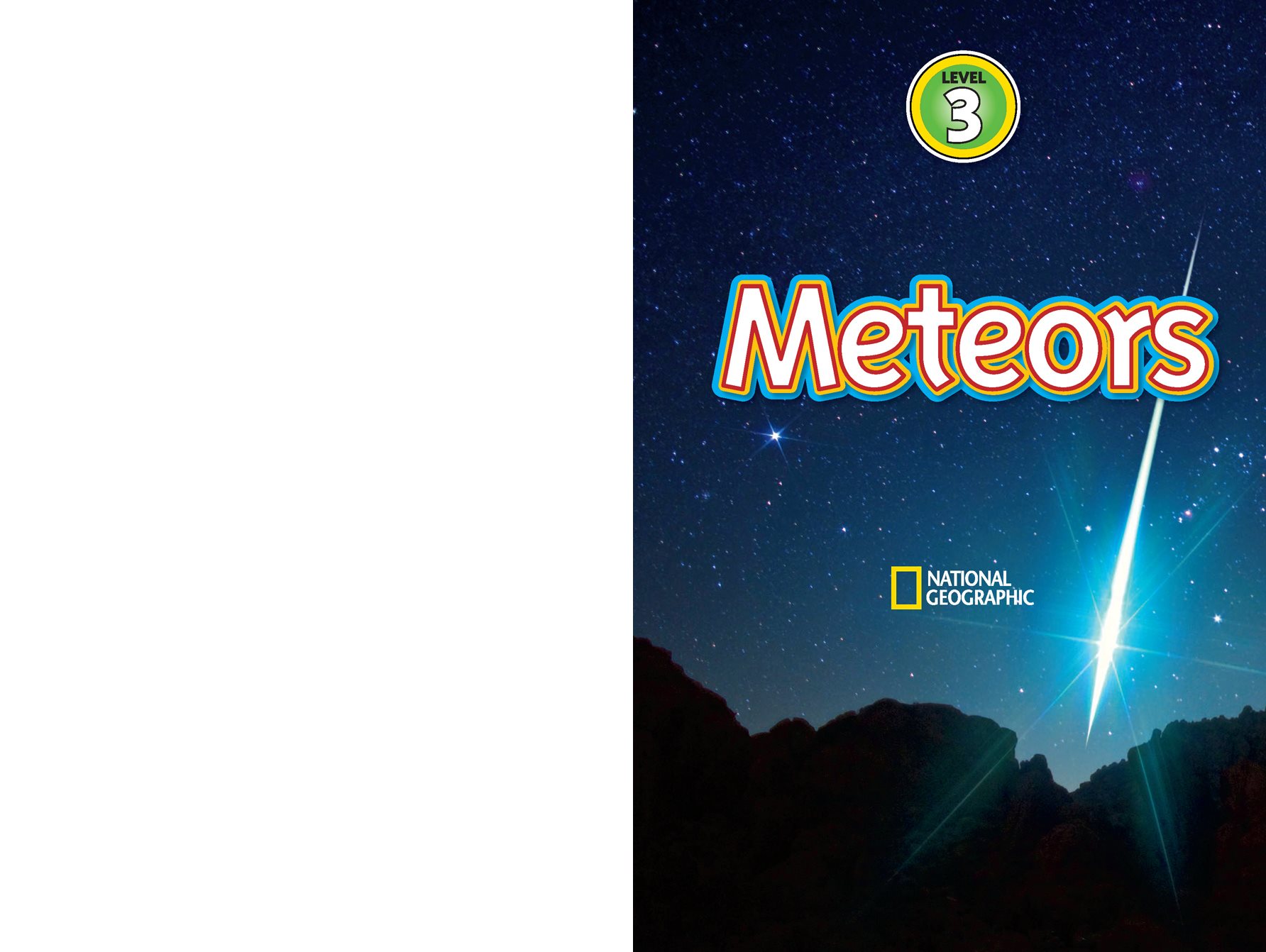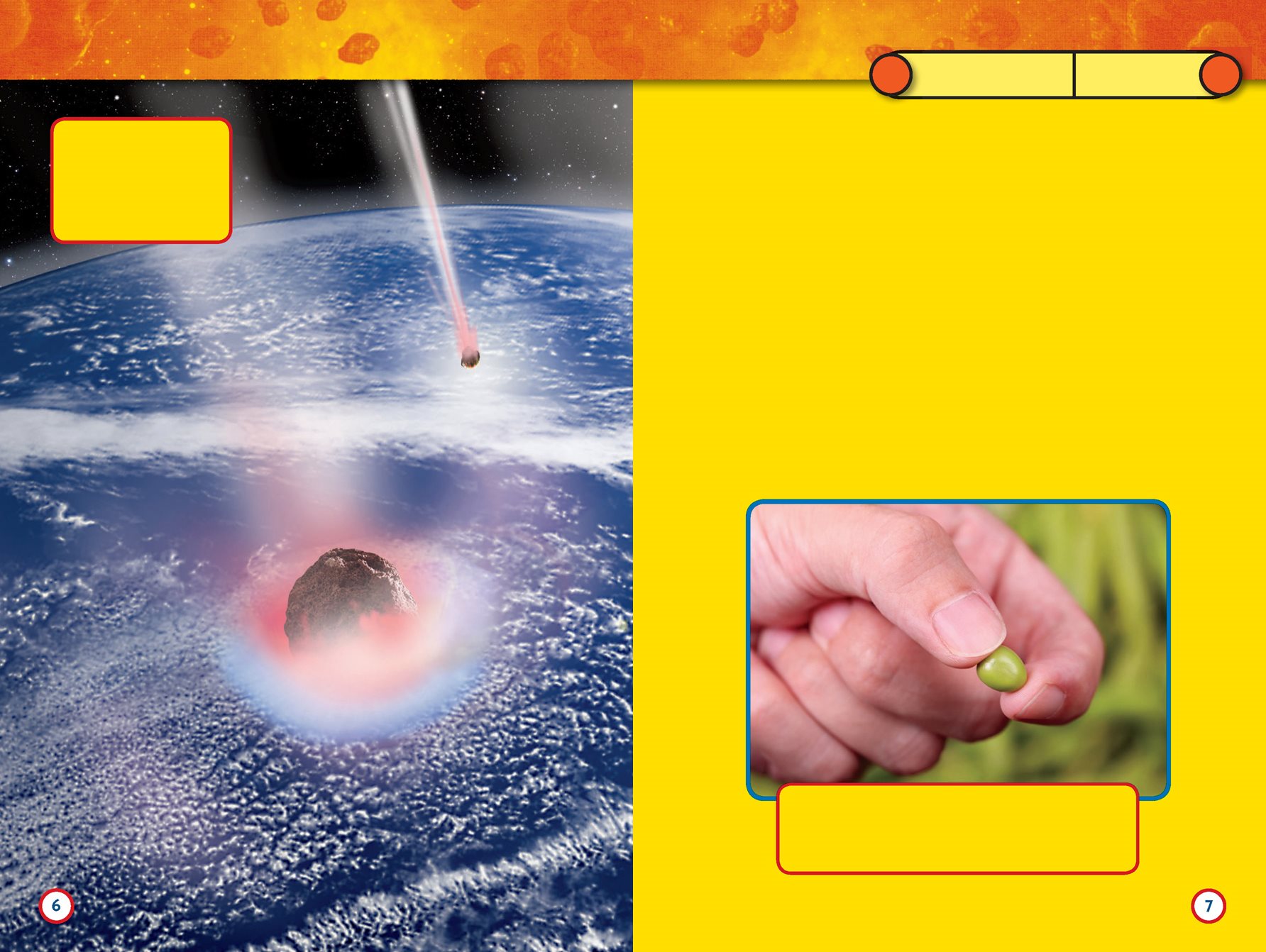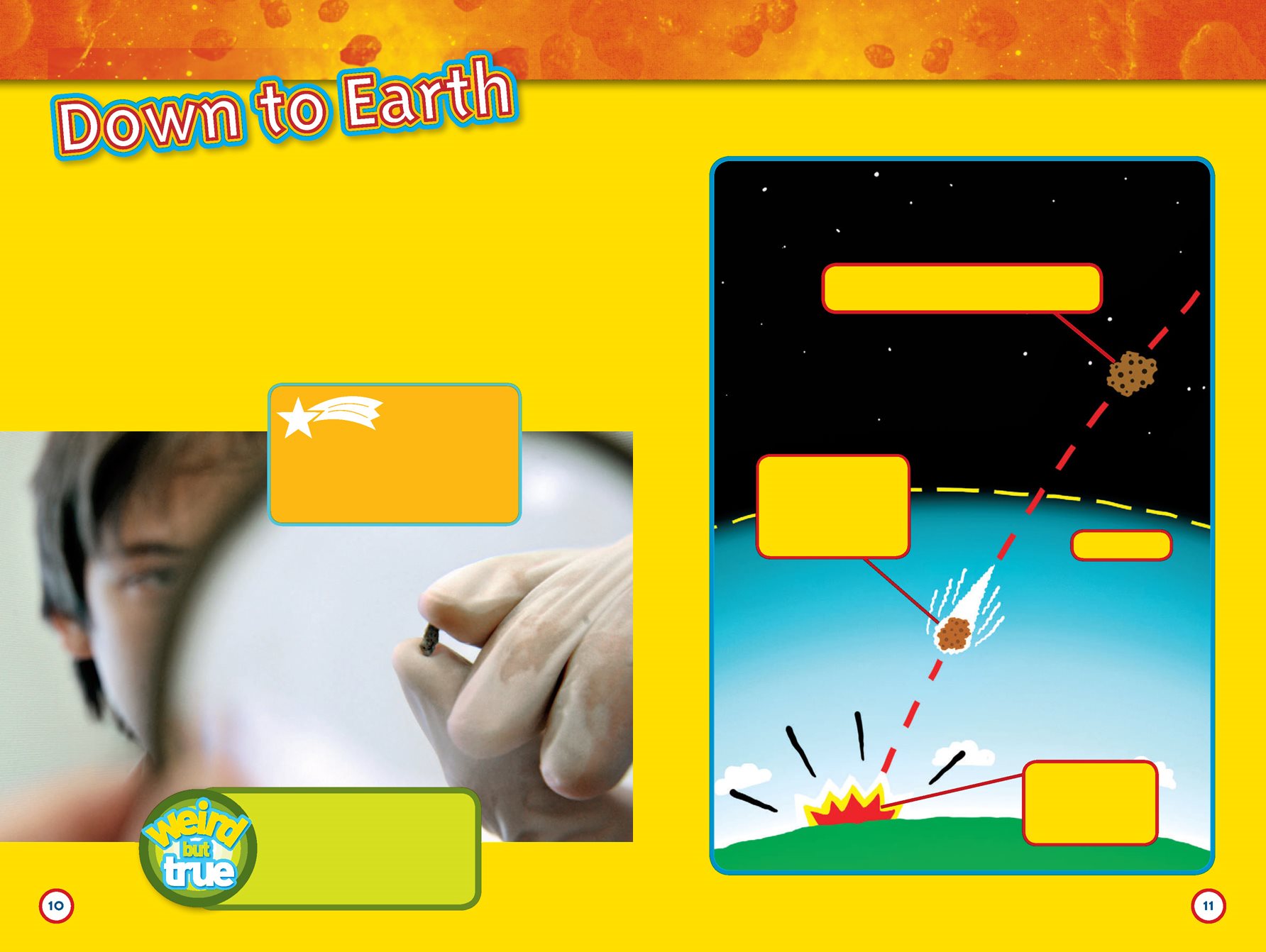Contents
Melissa Stewart
Washington, D.C.
For Bruce, whod like to soar through space
like a meteoroid. M.S.
The publisher and author gratefully acknowledge the expert review of this book by
Bill Cooke and Danielle Moser of NASAs Marshall Space Flight Center.
Copyright 2015 National Geographic Society
Published by the National Geographic Society, Washington, D.C. 20036.
All rights reserved. Reproduction of the whole or any part of the
contents without written permission from the publisher is prohibited.
Paperback ISBN: 978-1-4263-1943-3
Library edition ISBN: 978-1-4263-1944-0
Book design by YAY! Design
Cover, David Aguilar; 1 (CTR), Walter Pacholka, Astropics/Science Source; 2 (CTR), Tony and Daphne Hallas/Science Source; 4-5 (CTR),
Walter Pacholka, Astropics/Science Source; 6 (CTR), David Aguilar; 7 (LE CTR), Professor25/iStockphoto; 8 (UP CTR), benedek/iStockphoto;
9 (UP CTR), Michael Dunning/Science Source; 10 (LO), Aleksey Kunilov/ZUMA Press/Corbis; 11 (CTR), Billy Kelly; 12, Detlev van Ravenswaay/
Science Photo Library; 13 (LO), Detlev van Ravenswaay/Science Source; 13 (UP), Detlev van Ravenswaay/Science Source; 14 (CTR), Karel
Gallas/iStockphoto; 15 (CTR), Sinclair Stammers/Science Source; 16-17 (LO), BSIP/Science Source; 19 (CTR), Science Photo Library/Super-
National Geographic supports K12 educators with ELA Common Core Resources.
Visit natgeoed.org/commoncore for more information.
Printed in the United States of America
14/WOR/1
Stock; 20-21 (CTR), Detlev van Ravenswaay/Science Source; 22-23, JPL-Caltech/NASA; 23 (INSET), JPL-Caltech/NASA; 24 (CTR), Alex Cherney,
Terrastro/Science Source; 25 (CTR), David Aguilar; 27, Detlev van Ravenswaay/Science Source; 28-29 (Background), nienora/Shutterstock;
28 (UPLE), NASA; 28 (UPRT), Walter Pacholka, Astropics/Science Source; 28 (LORT), Stephen Alvarez/National Geographic Creative;
28 (LOLE), John Chumack/Science Source; 29 (UP), yurisan/Shutterstock; 29 (CTR LE), David Aguilar; 29 (CTR RT), Tomasz Wyszolmirski/
iStockphoto; 29 (LO), NASA; 30, Manfred Kage/Science Source; 31, NASA; 32-33, NASA; 33 (INSET), O. Louis Mazzatenta/National Geo
graphic Creative; 34, Dan Haar; 35 (UP), Europics/Newscom; 35 (LO), Linda Davidson/The Washington Post/Getty Images; 37, University of
Alabama Museums, Tuscaloosa, Alabama; 38, Emmett Given/NASA; 39 (RT), MSFC/MEO/NASA; 39 (LE), NASA; 40, Emmett Given/NASA;
41 (UP), Thomas J. Abercrombie/National Geographic Creative; 41 (LO), YONHAP/epa/Corbis; 42, powerofforever/iStockphoto; 43, Adolphe
Pierre-Louis/ZUMA Press/Corbis; 44 (UP), stevecoleimages/iStockphoto; 44 (CTR), O. Louis Mazzatenta/National Geographic Creative;
44 (LO), Detlev van Ravenswaay/Science Source; 45 (UP), Thomas Heaton/Science Photo Library/Corbis; 45 (CTR RT), Butsenko Anton/
ITAR-TASS Photo/Corbis; 45 (CTR LE), KarelGallas/iStockphoto; 45 (LO), JPL-Caltech/Cornell/NASA; 46 (UP), David Aguilar; 46 (CTR LE),
Arpad Benedek/iStockphoto; 46 (CTR RT), Cheryl Casey/Shutterstock; 46 (LOLE), Thomas J. Abercrombie/National Geographic Creative;
46 (LORT), Billy Kelly; 47 (CTR LE), Walter Pacholka, Astropics/Science Source; 47 (UPLE), Detlev van Ravenswaay/Science Photo Library/
Corbis; 47 (UPRT), David Aguilar; 47 (CTR RT), Detlev van Ravenswaay/Science Source; 47 (LOLE), PeteDraper/iStockphoto; 47 (LORT), BSIP/
Science Source; header, graphics.vp/Shutterstock; vocab, KamiGami/Shutterstock

Every day, thousands of small space
rocks enter Earths atmosphere.
Together, these meteoroids weigh
more than nine buses.
But dont worry. Most space rocks
never hit the ground. They burn up
as they fall through the atmosphere.
And that creates the fiery streaks of
light scientists call meteors.
If you watch the sky for
an hour on a clear night,
you will probably see
two or three meteors.
This time -lapse photo
captured six meteors in
just eight minutes!
Meteor
Meanings
ATMOSPHERE: The layer of gases
that surrounds a planet
METEOROID: A small rocky object
in space or the atmosphere
METEOR: The streak of light
produced as a meteoroid burns
up in the atmosphere
Some people call meteors shooting stars
or falling stars, but a meteor is very
different from a star.
Most stars are so far away that we could
never visit them. They burn bright for
billions of years. Most of the meteors we
see are about miles away, and their
glow lasts just a few seconds.
This illustration shows
a close -up view of
small meteoroids
beginning to glow
as they enter Earths
atmosphere.
Most of the meteoroids that enter Earths
atmosphere are smaller than this pea. They burn
up long before they reach our planets surface.
But some meteoroids are much larger.
Q
Why was the meteor
unhappy?
A
He knew hed
never be a star.
Why do meteors light up the night sky?
Think about it like this: On cold days, you
can warm your hands by rubbing them
together. You create heat because a force
called friction is at work.
Friction can be created in Earths
atmosphere, too. Some meteoroids cruise
toward our planet at more than 150,000
miles an hour. As a space rock rubs
against gases in the atmosphere, it creates
heat. All that heat makes it glow.
Meteor
Meaning
FRICTION: A force that resists
the motion between two
objects that are in contact
with one another
Not all meteoroids burn up completely as
they plummet toward Earth. The instant
a space rock lands, scientists call it a
meteorite. Most meteorites are no bigger
than a grain of sand, but some are as big
as a boulder.
Whats in a Name?
A small rocky object traveling
through space is called a METEOROID.
When it enters
Earths atmosphere,
it produces a
streak of light
called a METEOR.
If it strikes our
planets surface,
we call it a
METEORITE.
Atmosphere
Meteor
Meaning
METEORITE: A space rock
that lands on Earth, another
planet, or a moon
Around five hundred
meteorites land on Earth
each year, but only about
five of them are ever
identified as space rocks.
Scientists divide meteorites




